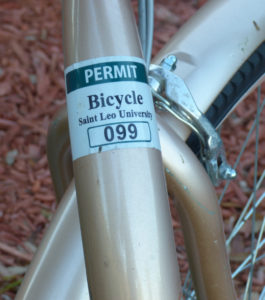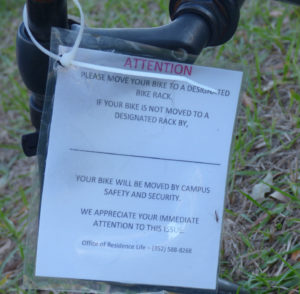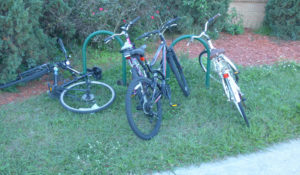By: Rhiannon Flanagan
Bicycles are often used as the alternative transportation to walking around the Saint Leo University campus. However, the simple vehicles have become problematic; locked on lampposts, parked lazily in front of residence halls and left without any form of identification.
Nevertheless, one might understand that the real problem with bicycles on campus is the lack of student awareness. For instance, many students have never seen the bike policy or heard of the registration process.
Ashley Butler, a resident assistant for the Marmion and Snyder residence hall, explains that someone helped her to register her bike; however, she did not know the process until she had someone else give her a hand.
For many students like Butler, the registration process is not clearly spelled out in any online outlets. Therefore, many students ride their bikes on campus unknowingly without registration and risk having their bike confiscated.
Accordingly, Campus Security has given insight into how a bike is confiscated after being parked inappropriately or unregistered.
“We’ll confiscate it,” said a member of the campus security department. “Either put it back here (campus security office), or if there is no room here, we usually bring it down to the parking garage.”

Bicycle Permits are available at the Office of Residence Life, on the ground floor of Apartment 6. Credit: Kadyann Stupart
Consistently, they explain how it is returned to the owner if reported missing. In efforts with residence life, they utilize the records kept at the residence life office to identify the owner, which is usually a difficult task if it is not registered.
“It’s a 30-day wait period, and we let Res-life know that we have it,” said the representative from Campus Security. “Most of the time a student will come running in here saying ‘somebody stole my bike,’ and we get a description, and they verify it and we give it back to them.”
The Office of Residence Life offers the official bicycle policy in their guide to residential living found on a web link to hubspot.net.
According to the guide, “Unregistered bicycles will be removed and stored at the owner’s expense. Unregistered bicycles will be tagged with a registration reminder notice no less than 14 days before they are to be removed. Bicycles that have been removed by Residence Life will be stored for 30 days; after 30 days the confiscated bicycles will be considered abandoned and will be disposed of.”

Many of the bikes that are improperly stored have tags with warnings of confiscation. Credit: Kadyann Stupart
Other than registering bicycles, students should store bikes in the correct manner and in the proper location. Improper storage of bikes leads to confiscation. As reported in the guide above, “Residence Life will attempt to contact the owners of bicycles stored, locked or abandoned in areas other than student rooms and bicycle racks (such as light poles, fences, stairwells, hallways, lounges, etc.). If the bicycle is not registered, it is subject to the same removal process.”
Accordingly, preventing situations like confiscation takes a quick registration at the Office of Residence Life. The Saint Leo website directs students towards contacting Residence Life to register and receive their free bicycle decal, and the office offers to answer questions and walk students through registration swiftly.
But for those in need of more information, the registration process is listed below:
1. Visit the Office of Residence Life
2. Fill out a form with a Saint Leo student ID number, phone number, bicycle serial number and the permit barcode number given at the Res-life office
3. Obtain a free bike decal with an identification barcode
4. Place the bike decal on the bicycle so that it may be identified if missing or stolen.
Once registered, students still might find that having a bike on campus can be somewhat problematic. Specifically, the issue at hand is the lack of bike racks and bike trails across campus. Furthermore, popular areas, such as the dining hall and the library, only have three spots for parking, while Saint Edward Hall has no spots for bikes. The large number of bicycles parked in the grass or up against buildings reveals this increasing problem. For example, there is a pile of bikes laying by the bike racks near the entrance of the Marmion and Snyder residence halls. Therefore, students may be at a disadvantage considering the lack of bike racks and the growing number of bicycles present on campus. Consequently, many of the bikes that are improperly stored have tags with warnings of confiscation.

The issue at hand is the lack of bike racks and bike trails across campus. Credit: Kadyann Stupart
Other than lack of storage, the steep hills and populated areas present some other issues, such as a concern for safety. For example, there have been claims of students falling off their bicycles while traveling on the populated sidewalks. Furthermore, some students have had struggles traveling down the hill to Marmion and Snyder, which included flying over the handlebars of their bicycle while attempting to hit their brakes to slow down.
AJ Oreto, a freshman commuter recalls the danger created for those walking in bicycle-populated areas of campus.
“I’ve been almost hit plenty of times because a lot of people tend to not pay attention to their surroundings and it’s pretty scary,” said Oreto. “When going up or down a hill, people tend to not watch for bikers, so they just need to be more observant.”
Generally, the area of campus featuring the Student Activities Building, Kirk Hall and the dining hall has daily traffic that makes it hard for those on bikes to navigate. More importantly, there is also a risk for those who ride recklessly, and it is something that is hard to control.
In regards to the issue of safety, Campus Security speaks to the use of any non-motor vehicles on campus and advises that students use the same legal discretion that they do on any road.
Correspondingly, the University’s code of conduct provides some rules and restrictions to the use of these modes of transportation.
Withal, the lack of student familiarity with bike policy and the abundance of bicycles on campus demands indefinitely for more precautions and storage availability to keep the university scenic and safe.





